Pictorially charting the period during which the HST's popularity really began to soar...

Looking seriously smart fresh from refurbishment, re-engined Arriva CrossCountry power car 43304 takes us back to the initial excitement of the new HST livery that emerged in 2008.
The ten year period between 1999 and 2009 marked a major rise in the popularity of the HST. The groundbreakingly futuristic train had left wide-eyed young spotters mesmerised upon its introduction in the 1970s. But by the 1990s, standardised in InterCity Swallow livery, it had become an ever-present wallpaper behind the much more varied realm of locomotive passenger haulage.

Classic late '90s. The original Virgin CrossCountry livery. Red and charcoal, with a yellow cab roof for the power cars. This is 43068 at Kings Norton on 10th September 1999.
However, the privatisation of British Rail through the second half of the '90s brought the HST back into focus. 1998 and 1999 saw a huge raft of old BR locos taken out of service, and simultaneously, for the first time, newly ordered passenger stock tangibly threatened the HST's reign of supremacy on diesel routes. Meanwhile, a sequence of new liveries spread across the HST fleet, creating a lot more appeal for the photographers who fed the enthusiasts' magazines. The scene was set, and fairly quickly, enthusiasts began to remember the excitement they'd felt when the HST first entered their world.

The holiday trains of the mid 2000s brought HSTs from alien regions into Worcestershire and Birmingham. Photographing the GNER sets became a weekly ritual through the summers. This set, captured at Stoke prior, features 43113 and 43290.
In the West Midlands and Worcestershire area, the next decade would offer a particularly varied wealth of HST liveries, which only served to snowball the trains' burgeoning fanbase. By 2005, certain summer Saturday HST runs through Birmingham had become unmissable photo opportunities - easily on a par in terms of compulsion with some of the celebrated freight trains of the 1990s. Standing on an overbridge while fellow photographers timidly explained to their wives that they wouldn't be home in time for lunch was not a new experience. But it had not happened before with HST duties.

Midland Mainline Rio sets also made multiple West Midlands appearances each summer Saturday through the mid 2000s. 43064 tails through Longbridge in summer 2005.
In this post, I want to immortalise the 1999 to 2009 period, in which the HST achieved star status. These were the sights that increased our appetite, and helped give British Rail's historic marvel the well-deserved iconic appeal it has today.
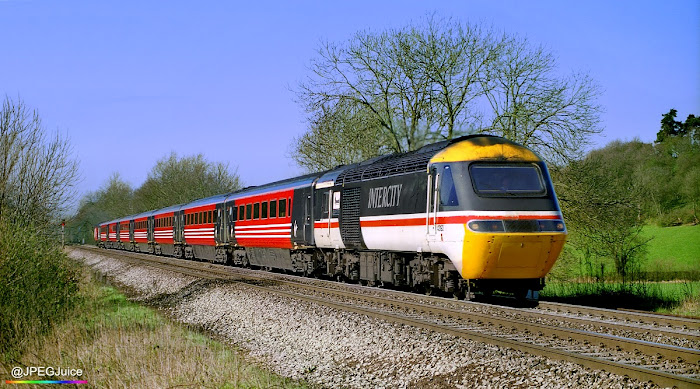
Although InterCity Swallow power cars were just too ubiquitous and monotonous to matter in the mid 1990s, five years later the remnant examples - which now only survived in very limited number with Virgin Trains - became one of the first real obsessive photo targets of this new HST era. Facing extinction, the IC jobs routinely appeared with Virgin red coaching stock, and looked striking offset against the newer livery. Above, we're on the Lickey Incline on 6th April 2000, witnessing 43193 tackle the climb. A year later, the last original IC power car - 43029 - disappeared, ending the connection with British Rail days.
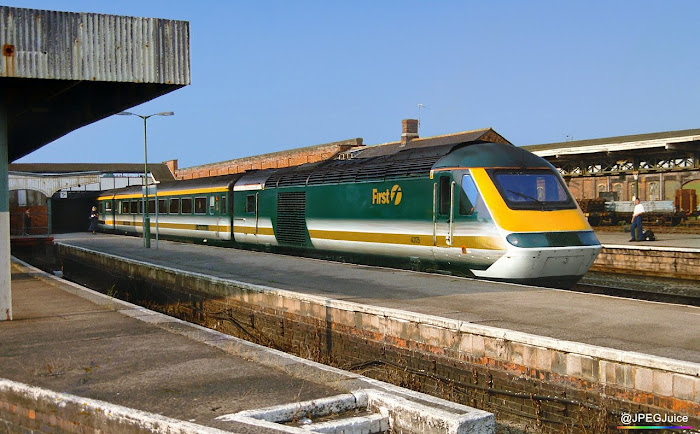
By 1999, First Great Western was onto its second HST livery, rendering InterCity Swallow two steps back in the timeline. Here at Worcester Shrub Hill, 43175 carries what was essentially a flatpacked update on the previous Great Western Trains aesthetic. Sometimes known as “Fagpacket” livery, because of its resemblance to a certain cigarette box, this look was standard until the original 'Barbie' livery (with white sections) tentatively arrived in mid 2001.
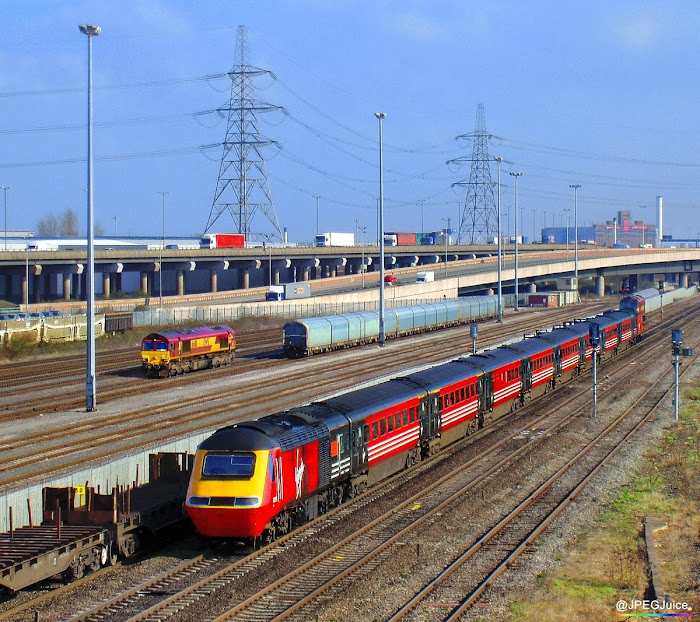
In Birmingham, the 1990s Virgin red and charcoal livery reigned supreme on HSTs in the early 2000s. The sets dramatically receded in volume from late 2002, and ceased regular CrossCountry use after the summer season of 2003. This was the last shot I took of a full, branded, original Virgin HST set. It's 1st March 2004 at Washwood Heath Yard, shortly before the West Coast sets were de-commissioned and the branding was abandoned. At the rear, nearest the camera, is power car 43092. 43084 is up front. By this time, appearances of full-length, branded Virgin HSTs were few enough to raise excitement - and also to underline what an attractive sight they'd been.
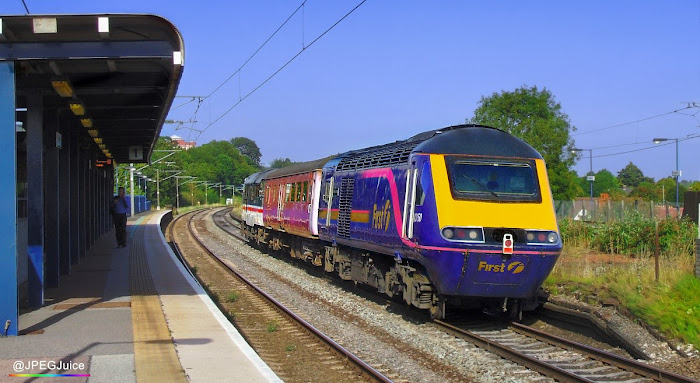
The First Great Western power cars' trips to Loughborough for refurbishment in the mid to late 2000s, were normally entrusted to Cotswold Rail Class 47s. On this occasion, however, 'Barbie' liveried 43150 is in the tow of InterCity Class 31/4 No. 31454. This is the revised 'Barbie' livery without any white, which turned out to be the prevailing version. It's 11th September 2007 at Northfield station, and the unusual consist is in the “four o'clock path”.
This was a commonly used northbound non-passenger window that was meant to directly follow Central Trains' 15:46 ex-Bromsgrove service up the Lickey Incline. FGW power car transfers had a habit of showing up in this path, which could alternatively be occupied by a stock move from Long Marston. The train would normally get to Northfield at around 4pm, but in the above scene it's late and out of its path. The time is actually 16:38.

Two liveries earlier, we find the same power car in its Great Western Trains guise at Worcester Shrub Hill, with the 17:34 to London Paddington on Sunday 5th September 1999. At this time, only a couple of select Hereford - Paddington services were scheduled to employ an HST, and the regular Worcester - Paddington trains were 'Turbo' units operated by Thames. In the mid 2000s, the Padd - Worcesters switched to FGW Class 180 units, before moving over to FGW HSTs as standard in late 2007.
On this particular Sunday, however - part of a cloudless weekend of railway specials at Shrub Hill - there was an excursion from St Budeaux to Worcester, which brought an additional Great Western HST to the station. The railway magazines advance-noted the St Budeaux - Worcester as it traversed some unusual territory for a FGW set. Other highlights at Worcester that weekend included a pair of 50s, a Res 47 in VSOE action, and 8F 48773 on a steam tour.
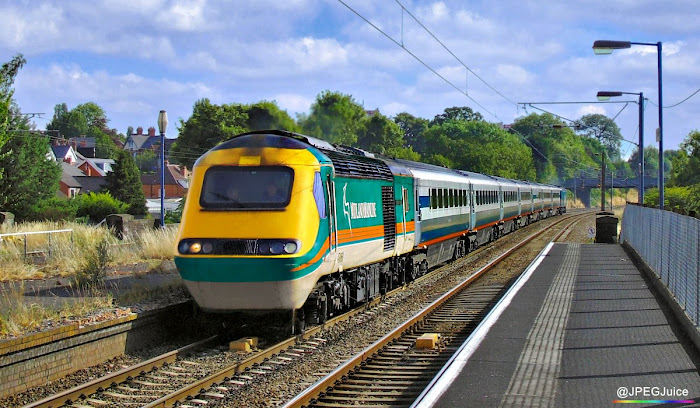
The summer of 2005 saw old Midland Mainline liveried 43060 making the 07:23 trip from Manchester to Newquay on several occasions. The power car, along with a couple of like-liveried 43s, a range of Rio MML jobs, and the de-branded GNER vehicle 43080, was set aside for this Virgin summer Saturday duty, as the Voyagers could not cover capacity and Virgin no longer had any HSTs of its own.

HST cover was scheduled from 9th July, but the diagram produced a double Voyager on the first Saturday. 43060 then worked the service at least three times, and there was an oldie MML power car at one end of the train for the majority of the eight-week period. Separately, Virgin hired full GNER sets for the 10:32 Paignton - Newcastle and MML sets for the 09:40 Newcastle - Newquay and 09:41 Newquay - Newcastle. On the NE-SW MML diagrams, de-branded Virgin red 43157 made multiple appearances. There's more on all this in the CrossCountry HSTs post.
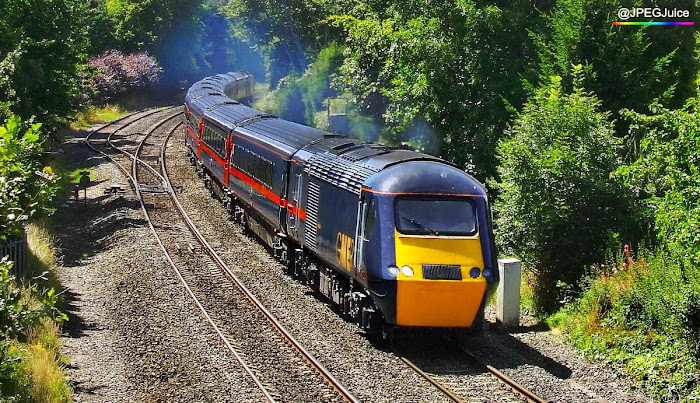
Virgin's use of GNER HSTs continued through the summers of 2006 and 2007. Here at Blackwell on 11th August '07, 43107 fronts the Paignton - Newcastle. Although this is an original Paxman-engined job, by this time GNER also had updated MTU power cars. It was thus possible to hear the scream of a Paxman car at one end of the train, accompanied by the booming purr of an MTU at the other.

By the following year, GNER had become National Express East Coast, and Virgin CrossCountry had given way to its Arriva replacement. The arrangement was slightly different, because unlike Virgin, Arriva was now operating its own HST sets. But extra cover was still required, as we see above. The image, from 2nd August 2008, was taken from the Blackwell foot crossing gate, and shows NX liveried 43309 heading a consist of amended GNER stock off the top of the Lickey Incline. The rear power car is 43315.

Although, by 2009, CrossCountry broadly had sufficient HST stocks to look after itself, it really did need all its sets to remain operational. So if a power car went down, you might see the unusual measure of a single third-party power car being roped in as a sole stand-in. The image above shows the unusual spectacle of National Express 43310 supplementing a regular XC set at Cofton. The rest of the composition was standard XC fare, including the rear power car. The date was Thursday 2nd July 2009.

The New Measurement Train proved to be an occasional highlight for HST fans, running with Paxman-engined power cars in the mid to late 2000s. Led by 43013 and tailed by 43014, the “Yellow Peril” makes for a striking vision at Bromsgrove, on the evening of 8th June 2006.
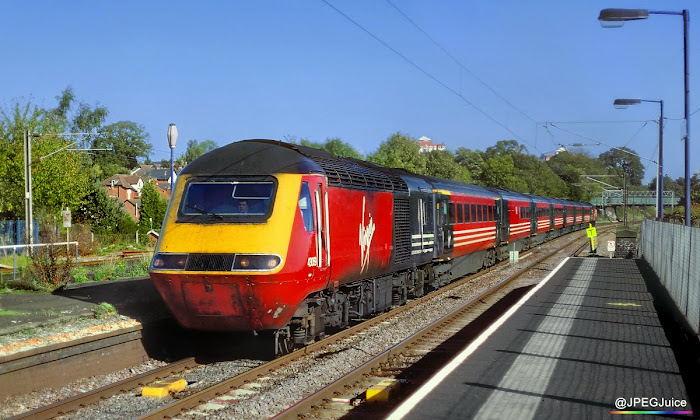
One of the power cars that saw fairly short-lived use on the New Measurement Train was 43089. Long before its days as Hayabusa, here's the anonymous '089 as a Virgin CrossCountry regular, at Northfield station on 22nd October 2001.
The shot comes from the final set of photos I captured on the legendary Kodachrome 25 film, which was on notice of discontinuation at the time. K25 was notable as an early high-saturation colour slide emulsion, which long pre-dated “supersat” films like Fujichrome Velvia and Kodak EBX. K25 had extremely high resolution and smooth grain, coupled with strong colour and great contrast. But it lost out to later films because it had a phenomenally low ISO speed of just 25, and it had to be sent away to Kodak for processing, which could take 1 to 2 weeks - unacceptable in the convenience age of the 2000s. Even on a sunny day, you'd need to compromise the camera's depth of field to freeze fast action with K25. But it was a fine choice for old Virgin red HSTs when there was a speed slack in force.
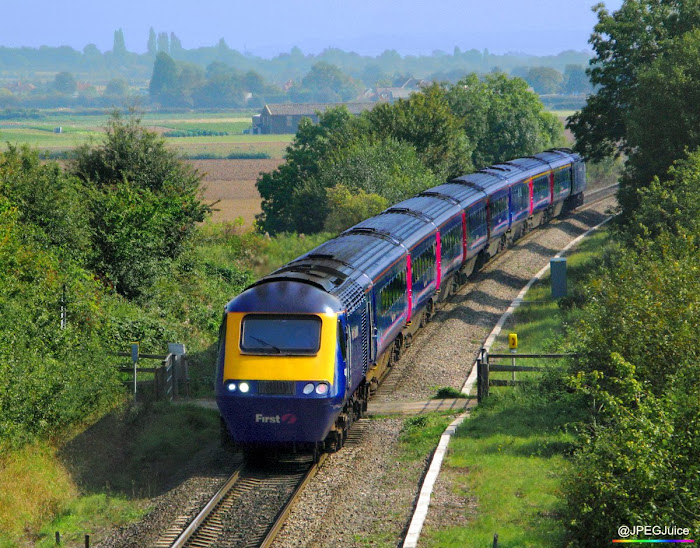
Heading out into the Worcestershire countryside, this is Wyre Piddle between Pershore and Evesham. The date is 20th September 2008, and by this time, the HSTs have replaced the Class 180s as the main means of rail travel between Paddington and Worcester. Heading for Worcester in the photo we see 43140 up front, with 43092 at the back.
I made this trip in a fascinating attempt to date an undated shot I'd taken at Pershore back in 1993. The undated '93 shot could only have been from Saturday 11th September or Saturday 25th September, and I wanted to know which it was. The plan was to use the length of the shadowfall cast by surviving, consistent-height objects, in combination with the time of day (marked by shadow rotation), to predict whether the 1993 trip had been earlier or later in the month than the 2008 trip. I was able to conclusively determine that the original trip took place on 11th September. Without the curiosity that prompted the 2008 journey, I would never have bagged this beautifully-lit HST shot.
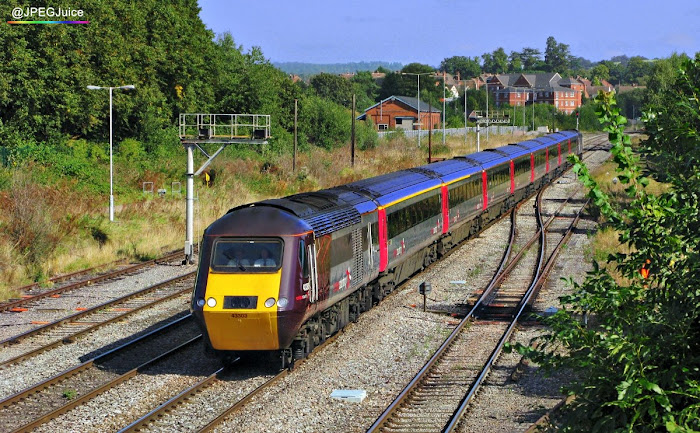
Nearly a year later on 9th September 2009, we find more attractive lighting south of Bromsgrove, to offset 43303 and its CrossCountry service, shoved from the rear by 43301. The front end livery implementation for these sets was clearly based on the classy and well respected GNER design.
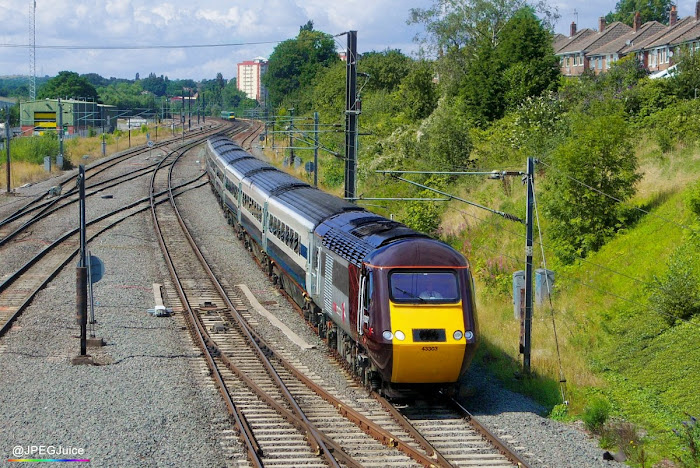
And heading back to summer 2008 when the same power car was ex-works post refurbishment, we enter the short period in which Arriva CrossCountry Class 43s ran with de-branded Midland Mainline stock. The location here is Kings Norton and the date is 4th August. The refurbished stock arrived in the autumn, and the new CrossCountry look was complete by November.

Returning to the era of full, branded, Rio liveried sets, this is the summer of 2007, once again at Northfield, where we witness 43082 tailing 43060 on the 07:23 Manchester - Newquay. By this time, you can see that 43060 has lost its original MML livery and now blends in seamlessly with the Rio image.

To wrap up, we're on the Perry Wood Walk overbridge near Worcester Shrub Hill, watching First Great Western 43018 storm towards the camera, aided by 43079 at the rear, as 158763 heads into Shrub Hill in the opposite direction. It's 13th May 2008, and 43018 had only been outshopped from refurb at Loughborough works just over two weeks earlier. This was the livery that followed revised 'Barbie', and as released from Loughborough the power cars were totally plain with no branding. The logos were added after the vehicles had returned to the Western Region.